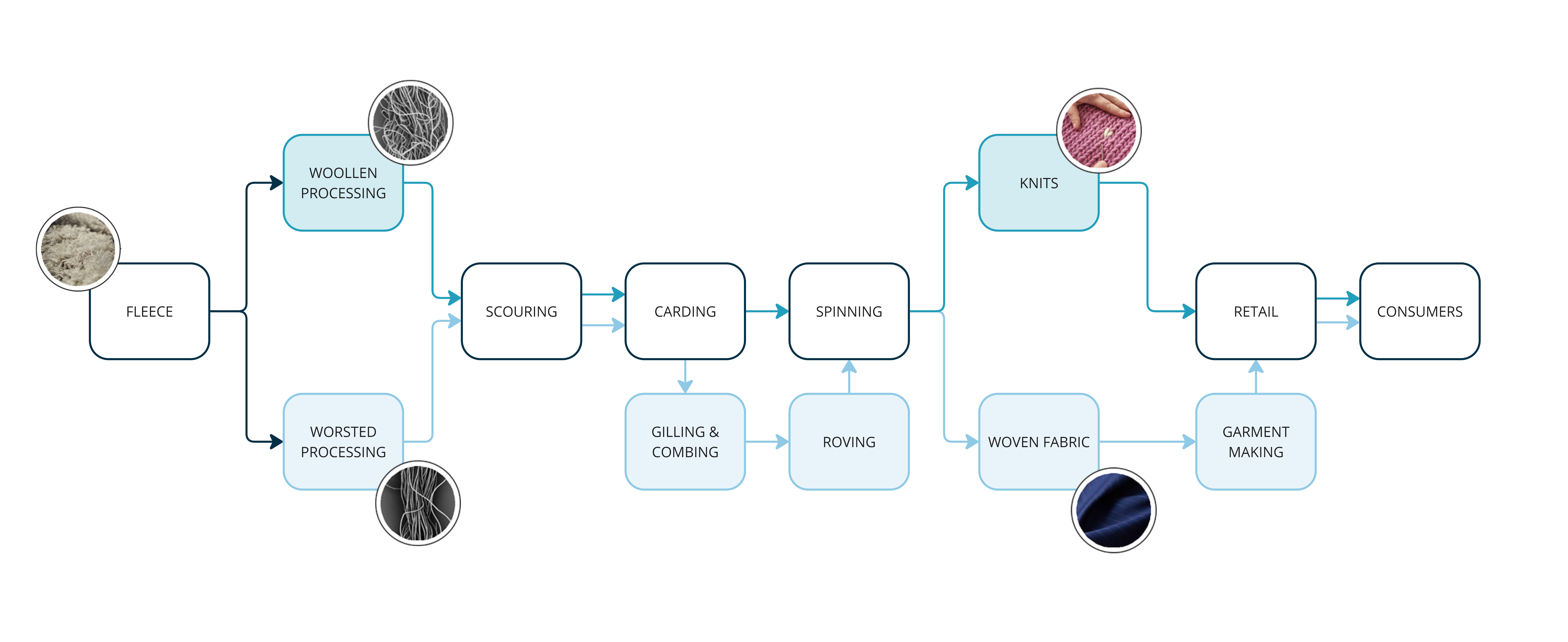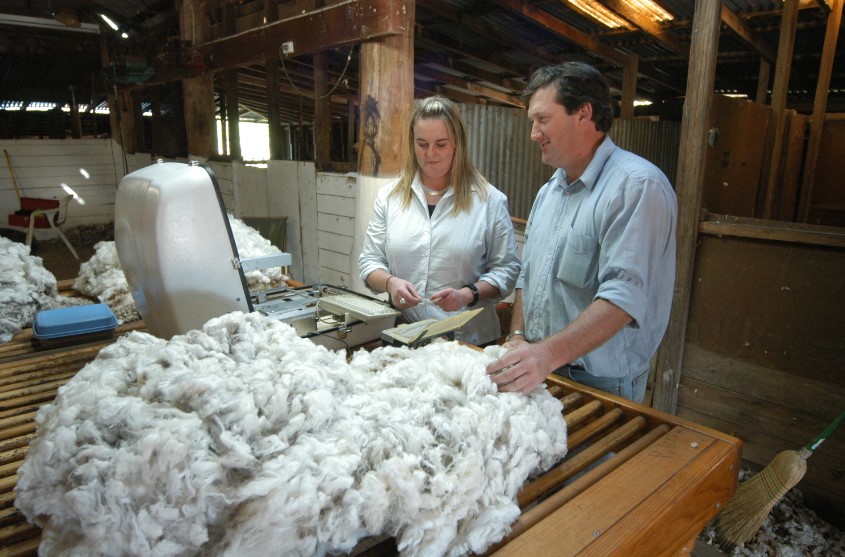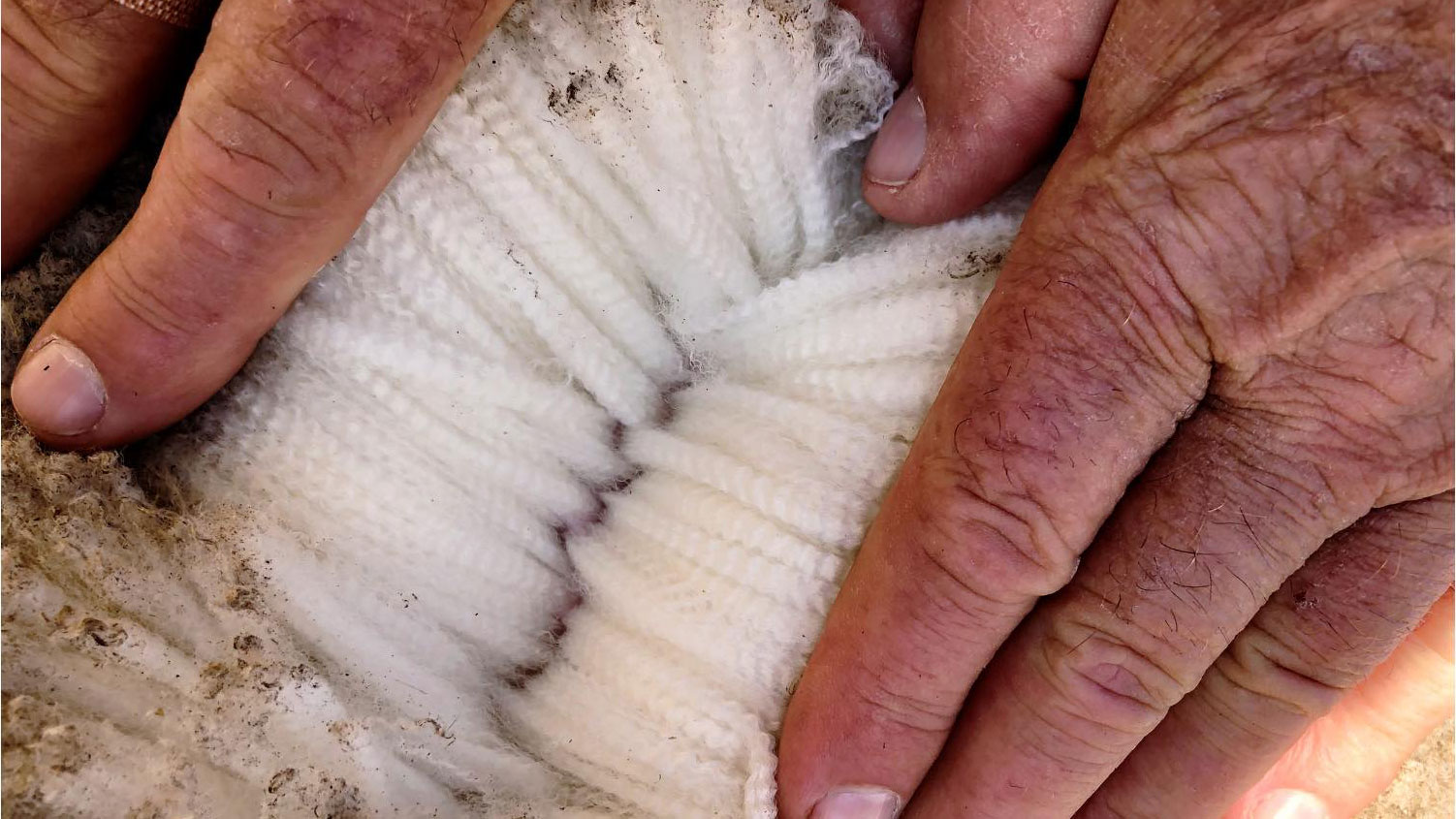Chapter 2.1 Know the features of your wool that influence demand and price
Chapter 2.1 Know the features of your wool that influence demand and price
Background information
The physical characteristics of wool that determine the price you receive are heavily influenced by genetics, level of nutrition, time of shearing, contamination (such as vegetable matter), and the way in which the wool is prepared for sale. In addition, any given wool type is subject to supply and demand factors that may alter within a wool selling season (short-term factors) or between wool selling seasons (long-term factors).
At a glance
- Understand the wool pipeline and identify the factors influencing demand and how they affect wool price.
- Know the important characteristics that influence price of wool at sale.
- Use a range of information sources to monitor the wool market.
The pipeline from woolgrower to consumer is long and complex and which processing route the wool is destined for is generally reliant on its length. A simplified outline is presented below.

Source: AWI
Around 70 per cent of Australian fleece wool and skirtings are traditionally destined for the worsted processing sector (over 60 mm in length) whereby all short fibres are removed. The longer fibres are combed parallel to each other, then spun on the worsted system to create a fine, strong yarn suitable for weaving.
10 per cent goes to the semi-worsted process (45-60 mm in length) which involves combing the fibres in parallel then being woollen spun, and generally knitted.
The remaining 20 per cent is made into woollen yarn used in knitwear (from fibre less than 40 mm) where fibres are carded (fibre brushed back and forth) with varying lengths of fibre then spun together in a loose yarn which is knitted into garments.
Influence on price
Prices received for raw wool are heavily influenced by physical characteristics. In general, three major physical factors affecting raw wool prices adversely in the market: position of break in the middle (POBM); overlong length; and AWTA certification suffix descriptor type. Discounts have been applied by the market to sale lines in the past few selling seasons that exhibited high (over 85%) POBM readings (when the wool was tested, 85% or higher of the point of break occurred in the middle of the staple, opposed to the tip or base of the staple), lines that tested over 110 mm in greasy staple length (SL) and to lines with certificates not suffixed with a P (lots that were not classed by an AWEX-registered wool classer).
These fibre characteristics are influenced by flock breeding programs, seasonal factors, on-farm management techniques, and in-shed classing.
Check out MMFS Module 9 Boost Business with Breeding to assist in your thinking about choosing sheep that are fit for purpose.
Pasture management throughout the year (see chapter 8.3 in MMFS Module 8 Turn Pasture into Product) and time of shearing are important influences on wool characteristics.
Certification type has an influence on price received. Issues often arise by the lack of enough similar wool to form a grower sale line resulting in wool having to be bulk classed (B & Q certificate suffix) in brokers store, woolgrower choosing to not use the services of a registered wool classer (D certificate suffix) or small lines not considered commercial by grower or wool selling broker that need to be interlotted (I certificate suffix). Discounts are applied by the market to all such certified sale lines, and broker advice should be sought to determine the best options available.
Lighter individual bale weights can also affect price returns, as per kilogram handling costs increase, which often reduces the amount the buyer and exporter can pay up-front for your wool.
Short-term wool market factors
Wool is a global product. Supply and demand factors can influence the raw wool market after you are committed to producing a particular type and style of wool in the current season. These may occur when:
- Stocks of wool in the form of tops and yarn build up in warehouses, and spinners slow down purchases of wool top, with corresponding implications for raw wool demand coming back along the supply chain.
- The quantity and quality of wool on offer does not match current buyer demand. Unusually or unexpectedly higher number of bales of similar wool types in sale weeks can often bear down on price levels. Conversely, lower than expected numbers can place upward pressure on market returns.
- Major trading currencies shift, for example, a sudden rise in the Australian dollar may cause wool prices to decline at short notice.
Wool brokers and advisors have current information to help you better understand these short-term factors.
Buyers also blend fleece wool to meet the specifications of a processor order. This is done because:
- Most mill lots are large and cannot be obtained from one sheep producer, or fleece wool of one type.
- Processing efficiency often requires wool to be of different types and from various growing districts and farms.
- It offers processors the opportunity to maintain continuity of supply of a similar blend throughout the year.
The practice of blending affects the supply–demand cycle. Wool of one spec is often blended with different types grown in Australia, as well as wool from other countries, to maintain a consistent, continuous supply of a particular blend that is required by a purchaser up the supply chain. This may explain price volatility for the same types of wool at auction on the same day and as processor orders are filled.
Long-term wool market factors
Some factors affect the market gradually, over a year or more. This provides an opportunity to respond with the type of wool produced. These factors include:
- An increasing consumer preference for light-weight apparel fabrics. Spinners and weavers have responded accordingly by increasing their demand for finer wool.
- Fashion trends and economic growth in the major industrialised countries. This affects consumer demand for textiles.
- Wool competes with synthetic fibres (polyester and acrylic), and natural fibres (cotton, cashmere, mohair and silk).
- Long-term trends in currency exchange rates.
- Growing casualisation in the workplace is causing a reduction in the wearing of suits by business people in many traditional markets. Counteracting slightly this trend is the uptake of suiting in some non-traditional wool markets in developing nations.
- Manufacturers are altering production processes to match and anticipate growing demand in markets for wool products, with the outdoor sportswear and next to skin lightweight garment sector a target. Formerly worsted spinner manufacturers have or are converting and replacing machinery and production to semi-worsted and knitwear operations, requiring different greasy wool requirements. Generally, this indicates a stronger demand long-term for shorter (40 mm to 70 mm S/L) wool.
The challenge is to breed sheep that fit both your environment and your markets. Such animals can be considered fit for purpose and are likely to improve your profitability. Sheep producers choose the type of sheep and wool that best suits the farm’s physical characteristics, management operations and production environment. For more information on setting your breeding objective to match your farm and environment, visit MMFS Module 9 Boost Business with Breeding.
Once a micron range and breeding line are selected, find out what characteristics or specifications processors require within that wool type, particularly those wool characteristics influencing price.

AWEX market reports and wool brokers’ reports and advice are sources of information that can be used to research the price implications of proposed changes to the sheep enterprise. The production and management decisions may range from:
- A shift from producing 21-micron wool (on average) to, say, 19-micron wool, while holding fleece weight at current levels; to
- Supplementary feeding in times of feed stress or seasonal changes in feed quality to reduce the possibility of tender wool (below 40 Newtons per kilotex {N/ktex}), especially where the position of break would occur in the middle of the staple; or
- Changing time of shearing, time of lambing, or increasing stocking rate.
In all cases, assess price information over a number of consecutive years, use your personal knowledge of the wool market, seek advice from your broker and broker’s management services to interpret the variations in price and consider potential financial gains.
Growing ultrafine Merino wool
This is an intensive, risky and highly specialised area of wool production. To achieve maximum returns from an ultrafine (finer than 16.5 micron) enterprise, quality is paramount. Vital attributes that are needed to achieve a profitable return are;
- High staple strength (S/S)
- Even and good length of fibre
- Finest micron possible
- Exceptional style and whiteness
- Soft handle
This market sector places extreme importance on excellent preparation of sale lines with an emphasis on uniform staple quality counts and strength. The cloth resultant from this area of production inevitably reaches the shelves of only a few of the world’s leading luxury tailors and commands an exclusive price tag, so any faults are heavily discounted. Low vegetable matter content percentage is essential. An Italian trade adage of “the finer the micron the better the wool has to be” should be kept front of mind.
As there are limited markets for this type of wool, keeping closely up to date on demand is key to being active in this market sector. A well-developed relationship through your wool selling agent to the manufacturer is important, not only in reaching satisfactory price returns, but in staying abreast of the latest technical specifications required and demand expectations.
Growing superfine Merino wool
The most important attributes of superfine wool (16.6–18.5 microns) that influence price received are:
- Fibre diameter
- Staple strength
- Staple length
- Position of break middle (POBM)
With most of the production in this superfine category heading for luxury apparel and increasingly to next-to-skin garment markets, the buyers of this wool are expecting an overall higher quality raw material than broader Merino types. Ideally the staple strength should be showing a measured reading of above 35 N/ktex. The ideal staple length (S/L) of lines should be between 70–90 mm S/L as a guide, and as even in length as possible, avoiding mixing short fibres and overlong through the main lines. Quality counts should be visually adjacent and consistent.
As a specialty area of wool production, the superfine market segment also places a strong emphasis on the woolgrower’s clip preparation standards. Woolgrowers can expect to receive a premium for sale lines within an obviously well-prepared clip. Significant discounts are applied to superfine clips that exhibit inconsistent quality and poor preparation, as the better wool in this sector is generally destined for sensitive, higher-value end uses such as Italian men’s suiting and women’s apparel lines.
Growing consumer trends for lighter weight, trans-seasonal and softer garments that can be worn next to the skin is increasing demand in this sector, with the development of new knitwear items in particular supporting greasy wool price. The high quality of the knitwear being produced now, and the high-speed machines being used, mean that the technical specifications of the greasy wool remain high, even though much of it is not being woven, but knitted instead.
Growing fine, medium and broad Merino wool
The most important attributes of fine, medium and broad Merino wool (18.6 micron and broader) that influence the price received are;
- Fibre diameter
- Staple strength
- Vegetable matter
- Position of break middle (POBM)
As this area of production is mostly treated as the “commodity market” of the wool industry, high average fleece weights are vital to a productive and profitable enterprise. The broader the fibre diameter the more weight of wool is needed per head as market pricing reduces lower for each point of a micron.
While the fibre diameter remains the key pricing variance factor, the percentage of position of break (POBM) in the middle test result has grown in its influence on price.
Greasy wool characteristic discounts are less stringently applied by the trade in this category and clip preparation standards are not overly demanding, although minimum code of practice standards are mandatory to achieve full market support.
Growing crossbred, downs and carpet wool
The most important attributes of crossbred fleece wool (25–32 micron) that can influence the price received are:
- Fibre diameter
- Dark and medullated and fibre free
- Style and colour
With a good portion of the Australian crossbred wool heading into the long knitwear sector, the ability to dye the end garment into modern day fashion pastel colours remains a key component. Where possible all kemp, medullated and dark fibre should be kept separate, as these faults can lead to heavy discounts for the crossbred wool producer.
The most important attribute of downs fleece wool (28–36 micron) that can influence the price received are:
- Compression resistance
- Vegetable matter content
The major end use destination of downs wool is bedding and quilting manufacturing. This requires a spongy quality in the wool which is the foremost influence on price. Vegetable matter content needs to be low for simply scouring rather than the more expensive (and sometimes damaging) process of carbonising the vegetable matter out of the fibre.
The most important attribute of carpet wool fleece wool (33–40 micron) that can influence the price received is a thick-stapled, durable wool type that will not break down under heavy use.
Australian Wool Production Forecast Report
The AWI Australian Wool Production Forecasting Committee publishes a forecast of Australian wool production three times a year to provide the best possible estimates of future sheep numbers for wool production (see signposts).
The committee releases its forecasts of production as a press release with a report that provides detailed forecasts, historical data and commentary on the key drivers of the forecasts. This report is a useful planning tool for woolgrowers.
Develop your own clip database
Establish a spreadsheet or use the ‘Clips’ function on Australian Wool Traceability Hub (AWTH) to record your annual production levels and quality and quantity of wool sold. You can then note the price received for each wool type and review these records to track progress towards your wool quality and production goals and embed it in your business plan (see chapter 1.1 in MMFS Module 1 Plan for Success).
SIGNPOSTS
WATCH & LISTEN
Discover the amazing journey of wool from the farm through the global supply chain to create innovative wool fabrics and garments. Wool is processed by two methods, worsted processing and woollen processing. Wool fabrics create luxurious, technical and eco-friendly products.
This 3D animation showcases the complex chemical structure of a wool fibre which allows us to delve into the makeup of the fibre and show why wool is one of the world’s most technically advanced fibres.
READ
Undertaking a broad review of the global market for wool and competitor fibres, AWI is able to provide wool production forecasting, retail and trade market reports, consumer insights and trend monitoring, along with fibre market research.
AWTA Raw Wool provides independent and objective wool certification and reporting services, including sampling, testing and certifying (e.g., yield, fibre diameter, vegetable matter content, staple length, staple strength, etc.), and reporting test results.
Market commentary from Macdonald & Co Woolbrokers.
As well as offering a range of daily and weekly market summaries detailing the current market movements, AWEX Market information provides real-time data during Australian wool auctions.
The latest on the Australian wool market direct from the Elders wool team.
Stay up to date with what’s happening in the wool market from the team at Nutrien.
What did the wool market do this week? Hear from AWN.
Jemalong Wool market insights.
Weekly market report from Moses and Son.
Every week, Quality Wool brings you a summary of the week in wool.
Weekly report and information pages from Schute Bell Badgery Lumby.
Market commentary from Macdonald & Co Woolbrokers.
USE
An industry owned and led initiative, the Hub is an opportunity for the Australian wool industry to get ahead of the curve when it comes to Australian wool's Emergency Animal Disease response plan as well as end-to-end commercial traceability from farm to first stage processor. For Woolgrowers, it provides ease of access to all their clip test information.
ATTEND
This course provides an introductory overview to the journey of wool from farm to fashion is designed to introduce you to wool processing and to products.
An in-depth look at the importance of wool price risk management and hedging principles. The content covers types of risk, risk management products, strategies and analysis and shows how a better understanding of these elements can enable an increased uptake of forward contracts and lead to improved market signals.
Contact your wool broker to organise a trip to the wool auctions. The auctions provide a valuable tool in providing production comparison to your wool clip. On the wool show floor, look at your own wool samples and take the time to view and compare other wools grown from your region and to a similar spec as yours. During the auction, take note of prices received by other growers. The wool sales also provide opportunities to interact with many of the exporters, giving a global perspective on pricing, preparation and future demand issues.






